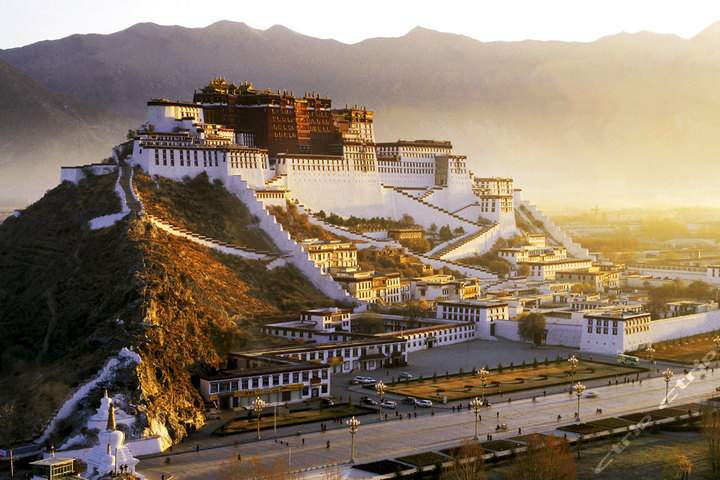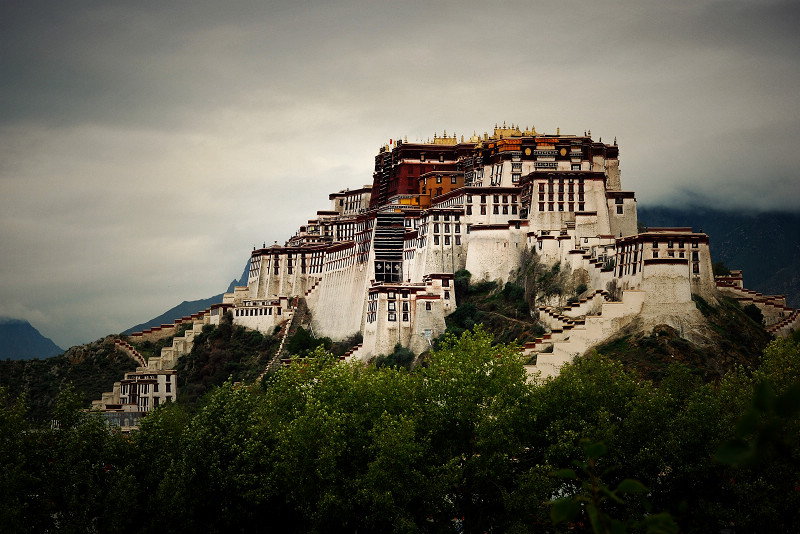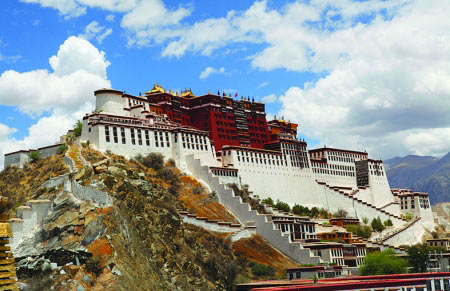Tibet's temples and palaces

When speaking of Lhasa, a clear image of the Potala Palace will immediately emerge in people's minds.
The palace seems to grow out of the top of the exposed rock, shaped like a "Z" on the peak of the mountain. The white palace has walls as wide as city walls that cluster around the central red palace, and three gold-plated pagodas stand tall and upright on the top, glittering in the sun.

The Potala Palace is built on an isolated mountain near the river called Red Hill, whose peak is 3,700 meters high, nearly 100 meters higher than the valley that lies below.
The Red Hill is steep, and the structure of the Potala Palace depends entirely on the topography of the mountain, as if the structure wraps itself up the mountain, blending together as one entity.

Because it was built on the flatlands of an isolated peak, it looks like an imperial palace of the heavens. You can see its majestic appearance from more than a dozen kilometers away.
The Potala Palace is not the only one of its kind in Tibet, a building that both rests on the mountain and combines parts of the mountain into its structure. Other famous structures like this include the Yumbu Lhakang in Nedong County of Lhoka Prefecture, Karchu Monastery in Lhodrak County of Lhoka Prefecture, Gyantse Castle in Shigatse, Tsedrup Monastery in Tengchen County of Chamdo City and the site of the Guge Kingdom Relics in Zhada County of Ngari Prefecture.

Some experts refer to this kind of architecture as fortress-style, while some call it cliff-style architecture, referencing the architecture's most important feature.
Some people believe the purpose of placing this kind of building on a cliff is for defense, while others believe it has to do with religion, in order to be able to speak with the gods. If the palace belongs to a secular political power, then the purpose is probably to express the idea of the "divine right of kings".
Aside from defense, placing a palace on a cliff also expresses the Tibetan belief of holy mountain worship. The structures that are built on top of and that blend together with the mountain are the epitome of holy mountain worship, a representative of the physical world. Building a structure in a high place is a way for devout Tibetans to communicate with the gods in the heavens, in order to let the mind be at peace.
Your Comment
Name E-mailRelated News
-
;
-
-

-
Tibetan Buddhist sutra exhibited in new branch of Taipei's Palace
A long-awaited new branch of Taipei's Palace Museum was inaugurated in Chiayi city of south Taiwan on Monday.
-
-
-

-
New look of Potala Palace as believers become painters
Every year in autumn and winter season, Potala Palace begins its annual painting work. Staff at Potala Palace Management office and Lhasa believers spontaneously take part in the work.
-
-
-
No need to book Potala Palace tickets in advance
The Potala Palace official website booking system switched off from 24th October, stopping all online ticket sales.
-
Based in Lhasa, Tibet Vista is a Tibet travel agency that specialized in Tibet permit, and Tibet tours for both private and group travelers at a local price!
•4 Days Lhasa City Group Tour from USD 460 •8 Days Everest Base Camp Group Tour from USD 850 •15 Days Mt.Kailash Group Tour from USD 1780 •2016 Tibet Train Tours from Beijing, Shanghai, Chengdu, Xining,etc










